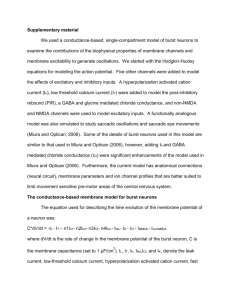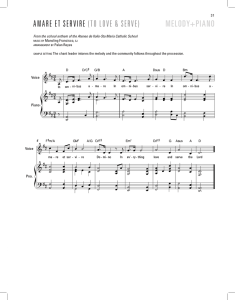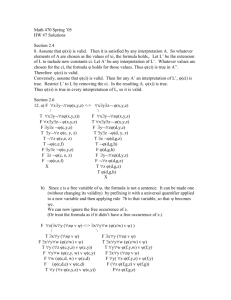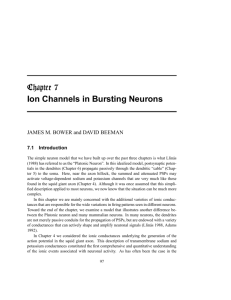Ionic currents were calculated from Hodgkin-Huxley-like
advertisement
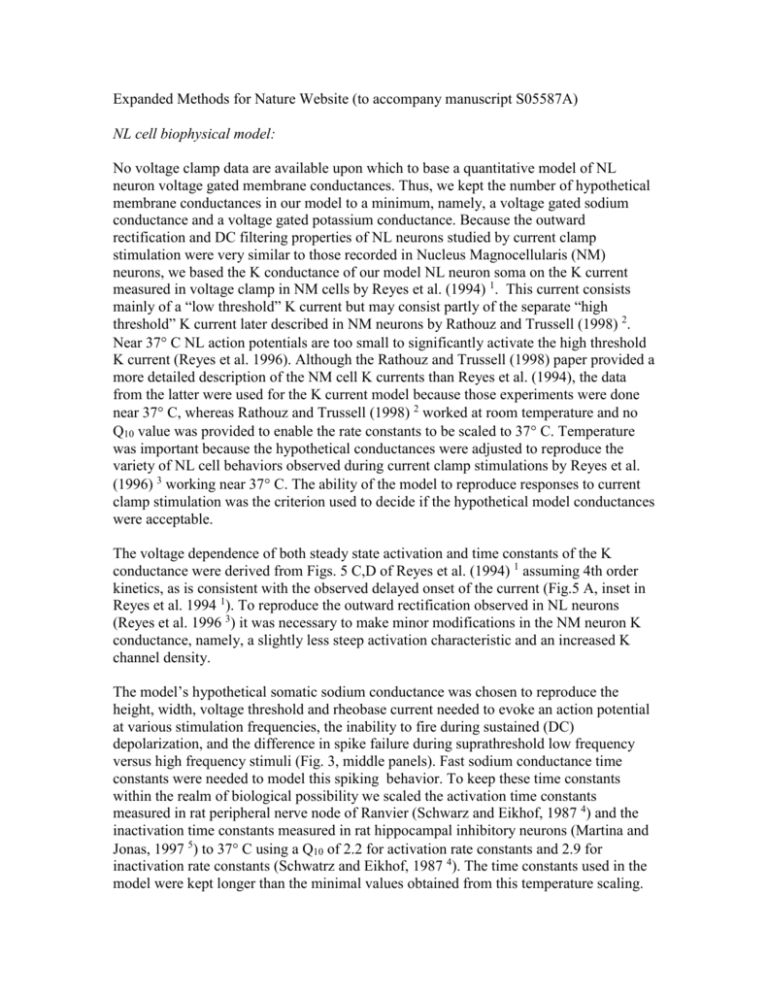
Expanded Methods for Nature Website (to accompany manuscript S05587A) NL cell biophysical model: No voltage clamp data are available upon which to base a quantitative model of NL neuron voltage gated membrane conductances. Thus, we kept the number of hypothetical membrane conductances in our model to a minimum, namely, a voltage gated sodium conductance and a voltage gated potassium conductance. Because the outward rectification and DC filtering properties of NL neurons studied by current clamp stimulation were very similar to those recorded in Nucleus Magnocellularis (NM) neurons, we based the K conductance of our model NL neuron soma on the K current measured in voltage clamp in NM cells by Reyes et al. (1994) 1. This current consists mainly of a “low threshold” K current but may consist partly of the separate “high threshold” K current later described in NM neurons by Rathouz and Trussell (1998) 2. Near 37 C NL action potentials are too small to significantly activate the high threshold K current (Reyes et al. 1996). Although the Rathouz and Trussell (1998) paper provided a more detailed description of the NM cell K currents than Reyes et al. (1994), the data from the latter were used for the K current model because those experiments were done near 37 C, whereas Rathouz and Trussell (1998) 2 worked at room temperature and no Q10 value was provided to enable the rate constants to be scaled to 37 C. Temperature was important because the hypothetical conductances were adjusted to reproduce the variety of NL cell behaviors observed during current clamp stimulations by Reyes et al. (1996) 3 working near 37 C. The ability of the model to reproduce responses to current clamp stimulation was the criterion used to decide if the hypothetical model conductances were acceptable. The voltage dependence of both steady state activation and time constants of the K conductance were derived from Figs. 5 C,D of Reyes et al. (1994) 1 assuming 4th order kinetics, as is consistent with the observed delayed onset of the current (Fig.5 A, inset in Reyes et al. 1994 1). To reproduce the outward rectification observed in NL neurons (Reyes et al. 1996 3) it was necessary to make minor modifications in the NM neuron K conductance, namely, a slightly less steep activation characteristic and an increased K channel density. The model’s hypothetical somatic sodium conductance was chosen to reproduce the height, width, voltage threshold and rheobase current needed to evoke an action potential at various stimulation frequencies, the inability to fire during sustained (DC) depolarization, and the difference in spike failure during suprathreshold low frequency versus high frequency stimuli (Fig. 3, middle panels). Fast sodium conductance time constants were needed to model this spiking behavior. To keep these time constants within the realm of biological possibility we scaled the activation time constants measured in rat peripheral nerve node of Ranvier (Schwarz and Eikhof, 1987 4) and the inactivation time constants measured in rat hippocampal inhibitory neurons (Martina and Jonas, 1997 5) to 37 C using a Q10 of 2.2 for activation rate constants and 2.9 for inactivation rate constants (Schwatrz and Eikhof, 1987 4). The time constants used in the model were kept longer than the minimal values obtained from this temperature scaling. Because the peak of the somatic NL cell action potential only reached about –15 mV (at 37 C) and action potential amplitude becomes even smaller during high frequency stimulation (Reyes et al. 1996 3), it is difficult to count spikes (thus, spike frequency) in an automated way during long computer runs simulating high frequency stimulation. The axon described below was attached to the model soma simply to conduct a full size action potential that could be recognized unambiguously. Merely for the sake of convenience Hodgkin-Huxley-like formulations of a voltage gated sodium current and a voltage-gated potassium current were incorporated into the nodes. The criteria for these nodal action potentials were that they be large and overshooting (i.e., easy to count), of fast duration and able to follow the same high frequencies as the somatic action potentials, and that they occur if and only if a somatic action potential was triggered by the same stimulation. The latter requirement was tested by using a variety of somatic stimuli and adjusting the steady state activation and inactivation characteristics as necessary to meet the requirement. NL model cell geometry: The model NL cell consisted of a soma (a 20 m sphere) with 18 dendrites (each 44.4 m long, 2 m in diameter) and an axon initial segment (20 m long) connected to a myelinated axon with 3 internodes (each 200m long) and 3 nodes of Ranvier (each 2 m long, 1.7 m in diameter). Nine dendrites received input from the ipsilateral ear and 9 received input from the contralateral ear. Synapses (up to 8 per dendrite) were distributed uniformly along the length of each dendrite. In spite of the presence of dendrites this model was equivalent to a point neuron because negligible attenuation of EPSPs occurred from dendrite to soma (unpublished observations; dendritic electro tonic length: 0.09). NL cell model membrane conductances: The specific resistance (Rm) of all neuronal membrane was 4712 -cm, resulting in a hyperpolarizing input resistance of 73 M(Reyes et al. 1996 3)The myelinated internodes had 100 times the Rm and 1/100th the specific capacitance as the value (1 F/cm2) for neuronal membrane. The same type of voltage gated conductances were placed in the soma, axon initial segment and dendrites. These differed from the conductances on the nodes of Ranvier as described below. The density of the dendritic sodium and potassium currents were 1/18th and 1/10th that of the soma, respectively. Ionic currents were calculated from Hodgkin-Huxley-like descriptions of the underlying whole-cell conductances. For sodium currents, INa = GNa*act3*inact* (V-ENa) and for potassium currents, (1) IK = Gk*act4*(V-Ek) (2) where V is membrane potential, GNa and Gk are the maximum whole cell conductance values, act is the steady state activation characteristic, inact is the steady state inactivation characteristic and ENa and Ek are the sodium and potassium Nernst equilibrium potentials, respectively. For each conductance the steady state activation and inactivation characteristics were calculated from the Boltzmann relations, act = 1/(1+exp((V1/2-V)/k)) (3) inact = 1/(1+ exp((V-V1/2)/k)) (4) where V1/2 is the potential of half activation or inactivation and k is a slope factor. Time constants (tau) of activation and inactivation for each conductance were calculated from the bell-shaped relation, tau = 2*[B + A/(exp(-(V+Vh1/2)/kh) + exp((V+Vd1/2 )/kd))] (5) where A,B Vh1/2,Vd1/2, kh and kd are constants. The values of the constants used in Eqns 1-5 for each conductance are given below in Table 1. 1. Reyes, A. D., Rubel, E. W & Spain, W. J. Membrane properties underlying the firing of neurons in the avian cochlear nucleus. J Neurosci 14, 5352-5364 (1994). 2. Rathouz, R. & Trussell L. Characterization of Outward Currents in Neurons of the Avian Nucleus Magnocellularis J Neurophysiol 80, 2824–2835 (1998). 3. Reyes, A. D., Rubel, E. W & Spain, W. J. In vitro analysis of optimal stimuli for phase-locking and time-delayed modulation of firing in avian nucleus laminaris neurons. J Neurosci 16, 993-1007 (1996). 4. Schwarz, J. R. & Eikhof, G. Na currents and action potentials in rat myelinated nerve fibres at 20 and 37 degrees C. Pflugers Arch 409, 569-577. (1987). 5. Martina, M. & Jonas, P. Functional differences in Na+ channel gating between fastspiking interneurones and principal neurones of rat hippocampus. J Physiol 505, 593-603. (1997). Table 1. Conductance parameters of NL cell membrane model specified by Eqns 1-5 Parameter: soma Na soma K node Na node K Max conductance, S/cm2 Equilibrium potential, mV Steady state activation V1/2, mV k, mV Steady state inactivation: V1/2, mV k, mV Activation tau: A, ms B, ms Vh1/2, mV kh, mV Vd1/2, mV kd, mV Inactivation tau: A, ms B, ms Vh1/2, mV kh, mV Vd1/2, mV kd, mV 0.04 40 0.006 -100 0.5 40 0.02 -100 -42 4.5 -54 9 -26 9.3 -51.1 5.1 -50.5 4.5 - -50 7.1 - 0.05 0.0030 40 19 40 19 0.8 0 50 15 50 15 0.0244 0 26 26.3 26 26.3 1.5 0 54 7.5 54 7.5 4 0.01 46 4.5 46 4.5 - 1.145 0 50 13.3 50 13.3 -


